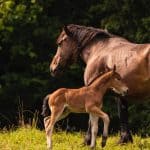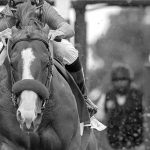If you’re questioning the timing of when to start your young horse, read on!
Working with young horses can be among the most wonderful and enriching experiences in a horseman’s career. It’s not only a joyful time (healthy young horses are innocent, playful and fun-loving), but it’s also an important time in terms of physical and mental development.
Working with young horses will give you an opportunity to experience the earliest days of the athletic development process, and a firm understanding of training at this stage will also give you insights into foundational problems that don’t become obvious until more advanced training begins.
I have worked with more than a few horses whose owners thought their horse simply lacked ability, but it turns out that what their horse really lacked was solid foundational training. For more on this, see In Defense of the Average Horse. Especially with youngsters that are slow to mature either mentally or physically, this slow maturation is often mistaken for lack of ability.
DO’S
- DO TAKE X-RAYS: When you’re ready to start a horse and you want to have a high level of confidence that the horse is structurally ready, have your vet take X-rays of the knees and decide whether training should commence based off of what your vet sees there. (Top horsemen have been doing this for decades.)
- DO RESEARCH YOUR HORSE’S BLOODLINES: Late and early bloomers tend to run true in terms of genetics. If you are lucky enough to know your horse’s pedigree, do some research. Can you see performance patterns in the bloodlines in terms of slow maturity versus fast? Also, read articles on the famous ones if you can. Their handlers often will tell stories about the ups and downs of a horse’s career prior to entering the breeding shed, and this may give you further insights. If you don’t have access to pedigree, get as acquainted as you can with the breed (or mix of breeds that is your horse). Arabians can be slow to mentally mature. Heavy boned draft horses take longer to physically mature.
- DO TAKE MENTAL MATURITY INTO CONSIDERATION: Your horse may be a picture of physical perfection, and with your trainer, your vet, and growth plate X-rays indicating it’s time to start. However, if your youngster has zero ability to focus, spends more time walking around on hind legs than all four, or otherwise “can’t seem to get it together”, think about giving your young equine partner another 6-months.
- DO EXPECT GROWTH SPURTS: We all went through this stage around middle school or high school but it didn’t stop us from being active in learning and playing sports. Just don’t overdo it. If you can remember this time in your life, know also that growth spurts can cause awkwardness for your young horse. Don’t beat yourself or your horse up if your horse occasionally seems to have two left feet and seemingly simple things don’t seem achievable at the moment. Support your awkward duckling through these spurts with patience, praise, and encouragement.
- DO ANALYZE AND KNOW YOUR HORSE’S CONFORMATION: If your horse has conformational difficulties extant (even if they seem mild), do take that fault (or faults) into consideration not only when starting, but throughout the horse’s career in order to maximize the horse’s working life, it’s joie de vivre, and its soundness. If you have a dressage horse that’s sickle-hocked, teach a little collection for the good it does for the rest of the body, but don’t endlessly ask for collection and sit it on its haunches. With a horse over at the knee, teach that horse to jump admirably at 2’3″, but no no need to do endless repetitions of gymnastics and jump lines.
- DO TREAT EACH HORSE AS AN INDIVIDUAL: Just because your best friend’s sleek show mare was started at 3 years old and winning at 4, doesn’t mean your oversized, gangly, and immature young 3 year old colt is ready to do the same.
DONT’S
- DON’T WAIT FOR ALL GROWTH PLATES TO FUSE: Growth plates in the legs show us what stage of growth a horse is in. During growth, a bone lengthening process occurs where new bone cells are being created and laid down on either end of the long bones in question, and in terms of succession, they start closing from the ground up (i.e. the ankles close before the knees and so on, up to the wither). We can take a snapshot of this growth process by taking X-rays of the joint and as mentioned above, images of the knee will give you a very good idea of whether you are safe to start your horse. But, don’t wait for ALL growth plates to fuse: 1) if you do, you will be waiting until your horse is in its early teens, and 2) if you want to reduce the likelihood of injury throughout your horse’s career as well as have your horse build strong bones to support strong tendons and ligaments as training progresses, you shouldn’t do this. See my next point for more on this.
- DON’T BUILD BONES BASED OFF OF GENETICS ALONE: With regard to bone development in young horses, studies show that appropriate exercise during development creates an environment of better bone-resource utilization. This is where the biology and cell function becomes more efficient, and what results is a denser, more uniform bone capable of higher load capacity than if relying on genetics alone. Now this is a really important point for horses slated to become athletes: the quality of bone modeling that we see during the growth stage, ceases at maturity and switches to a predominantly remodeling function (think fracture repair, or arthritic changes). So, it is during stages of growth – when bone cell production and blood supply are maximized – that we want to trigger the horse’s bone creation resources to model denser, more uniform, and stronger bones. This is similar to the more familiar damage/repair processes that take place in muscle development on a cellular level. The body recognizes that muscle tissue has been damaged and it works to lay down fresh new tissue that makes that muscle stronger and bigger. We can give our horses among their best chances at maximizing skeletal strength (including the strength and integrity of skeletal supports like tendon and ligament by starting training at the right time: you want the knees closed, but you want bone growth and the blood supply that supports that bone growth to be active still.
- DON’T JUST USE AGE AS A DETERMINANT: Using age as a determinant can be a slippery slope. Different breeds mature at different rates and individual horses within a breed mature at different rates. Thoroughbreds mature slightly faster than warmbloods for example, but waiting until your warmblood is 7 or 8 to pull him out of the field for the first time is likely too long and (as explained above) you are increasing the probability that you will be dealing with a higher occurrence of sports injuries during that horse’s athletic career.
- DON’T OVER-PRACTICE: Over-practice is a very good way to ruin a horse of any age, both mentally and physically (read The Invisible Line: Obedience vs Partnership). For example, I have never once met a horse that has forgotten how to do a flying change, no matter how long it has been since its last one. If your change is sloppy, it’s not the flying change that needs practice but rather, you need to work on improving your balance and stillness, or your horse’s fitness and strength, etc., none of which require repeated (and dulling) executions of lead change to improve.
- DON’T START YOUR FIRST ONE ALONE: Starting a young horse and that horse’s consequent foundation-training is an area of work that can be rife with pitfalls for the inexperienced. If you’ve never started a horse before, find a professional that’s worked with and started as many youngsters as possible. This will help you develop a horse that is healthy, confident, and well-adjusted. That expertise will also give you reassurance in what you’re doing as you progress.
From first backing to first show, and all the wonderful rides in between, best of luck to you and your new partner!
Euki is the founder of Adaptive Development EQ and currently coaching and consulting in Denver, Colorado. She loves helping people get inspired about the developmental process of holistic/whole-horse training, and is on a mission to help riders and owners rediscover their horses, and fall in love with them all over again.






